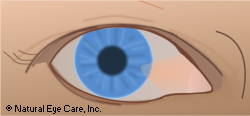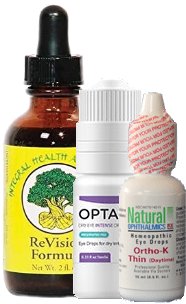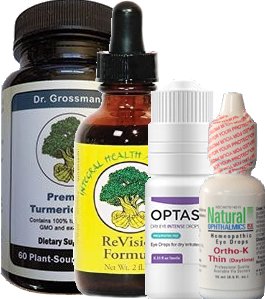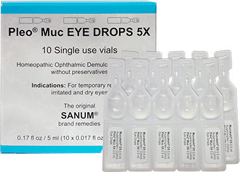Pterygium
Nutrients Symptoms Causes Self help discussion News
Pterygium vs Pingueculae
A pterygium is a raised, cream colored growth usually on the nasal side of the white of the eye. It sometimes is more transparent, or can be yellowish or reddish. Before the growth extends onto the cornea it's called a pingueculae. When it extends onto the cornea it's called a pterygium.
Vitamins & Supplements
Discount Packages |
Very Important |
Important Helpful |

Pterygium is a benign but uncontrolled growth of conjunctive cell tissue. The conjunctiva is a thin layer that lies on the sclera, the white of the eye. Researchers have found that pterygium is linked to less dense corneal endothelial cell tissue, as well as an increase in astigmatism.
Although pterygium is traditionally considered to be degenerative in nature, certain gene characteristics (WWOX) suggest that it is actually "premalignant" tissue, and that the WWOX gene may play a role in the growth and recurrence of pterygiums.4
Although they can be removed surgically, the rate of recurrence is as high as 40%, and they tend to come back bigger and faster. A pterygium is not dangerous and it is not cancer, but can become uncomfortable. The main problem is that they can eventually distort vision due to the fact that they can grow onto the cornea, and eventually even onto the central part of the eye blocking light from entering.
Symptoms
Raised, cream colored growth usually on the nasal side of the white of the eye.
Other symptoms include an itchy or gritty feeling in the eye, redness, and possibly a sense of burning. As it becomes more advanced, it can become inflamed, causing redness and irritation as well as affecting vision if it starts to cover the cornea.
Pterygium are not the same as xanthelasma, which consist of cream colored growths around the eyes, again, mostly on the side toward the nose. Xantheslasma are deposits of cholesterol near the eyes. Contrary to popular belief there is no conclusive evidence that these are linked to high cholesterol levels or heart disease caused by hardening of the arteries. These can also be surgically removed.
Causes
These growths are usually caused by dry, hot, windy environments, and are found often on people that spend a lot of time outside. Researchers are beginning to understand what brings about these changes, possibly due to factors that include genetic modification and virus infection.
Sun and wind.There is a higher rate in people living near the equator. In the United States, the incidence is less than 2%. In Florida and California, the incidence to close to 4%. By the equator, the incidence goes up to 20%. The condition is sometimes called surfer's eye since it is more common in people exposed to wind and the UV radiation of the sun.
Meibomian Gland Misfunction. New research explores a possible missing link between dry eye and pterygium: malfunctioning meibomian glands. Scientists found correlation between degree of meibomian gland structure problems and severity of pterygium incidence. The meibomian glands produce an oily substance called meibum which spreads thinly over the surface of the eye helping to protect the tear film. When such production is insufficient then not only does dry eye syndrome result, but there is apparently greater risk for pterygium development.2
Dry eyes. There is correlation between how fast the tear film protecting the cornea breaks up, and how concentrated the tear film is.3
Genetic changes. Researchers have also discovered that genes are associated with pterygium. These include tumor suppressor gene p53, and WWOX, and other genes that are linked to the maintenance of DNA, cell growth, cell movement, and cell death.5,6
Virus. Human papillomavirus infection is also a risk factor in some parts of the world and is associated with pterygium.7,8
Renal failure. Although renal failure results in conjunctival lesions that may appear to be pinguecula, there is one study that found that patients with renal failure had a higher rate of pinguecula than healthy-eyed patients.9
Conventional Treatment
If the pterygium is interfering with your vision, then typically it is removed surgically. Otherwise, it is left alone. The rate of recurrence is as high as 40%, and they tend to come back bigger and faster.
Complementary Treatment and Self Help
New research indicates the potential for curcumin in inhibiting pterygium growth. Scientists incubated pterygium cells with curcumin (the principal component of turmeric) and found that growth was significantly inhibited.1
Ophthalmic lubricants without mercury compounds or anticholinergics and MSM eyedrops can be helpful. These eyedrops help soften the membranes, allowing fluids to pass through the outer layer of the tissues. When tissue membranes become permeable, nutrition is able to penetrate through the outer layer and provide the nutrients needed for the body to try to manage the pterygium growth.
In addition, these eyedrops equalize pressures, repair damaged membranes, clear up red spots and broken vessels, and help remove blemishes and other tissue particles.
While MSM eyedrops can be specifically helpful, the following are general points which are more generally very important for your vision.
- Protect your vision from damaging UV radiation with good quality 100% UVA/UVB protecting wraparound sunglasses. Amber or brown are the best colored lenses for protecting the eyes, and the lenses should be polarized as well to reduce glare.
- Supplementation with nutrients and eyedrops that have been found to be helpful to protect vision.
- Diet & lifestyle recommendations - see our protocol for healthy vision for more information.
Pterygium News
Want to learn more? See our blog for news on pterygium.
Footnotes
1. C.W. Lu, J.L. Hao, et al, Efficacy of curcumin in inducing apoptosis and inhibiting the expression of VEGF in human pterygium fibroblasts,
International Journal of Molecular Medicine, April, 2017.
2. H. Wu, Z. Lin, et al, Meibomian Gland Dysfunction Correlates to the Tear Film Instability and Ocular Discomfort in Patients with Pterygium,
Scientific Reports, March, 2017.
3. M. Ozsutcu, et al, Tear osmolarity and tear film parameters in patients with unilateral pterygium, Cornea, November, 2014.
4. Huang, Y.H., Chang, N.S., Tseng, S.H. (2015). Expression of WW domain-containing oxidoreductase WWOX in pterygium. Mol Vis, Jun 25;21:711-7.
5. Liu, T., Liu, Y., Xie, L., He, X., Bai, J. (2013). Progress in the pathogenesis of pterygium. Curr Eye Res, Dec;38(12):1191-7.
6. Ibid. Huang. (2015).
7.Ibid. Liu. (2013).
8.Di Girolamo, N. (2012). Association of human papilloma virus with pterygia and ocular-surface squamous neoplasia. Eye (Lond), Feb;26(2):202-11.
9. Cohen, S.L., Gorchein, A., Hayward, J.A. (1974). Pingueculae - An Association with Renal Failure. QJM, Apr;43(2):281-291.
 info@naturaleyecare.com
info@naturaleyecare.com



 Home
Home



 Vision
Vision Vision
Vision



 Health
Health Health
Health Research/Services
Research/Services Pets
Pets About/Contact
About/Contact





